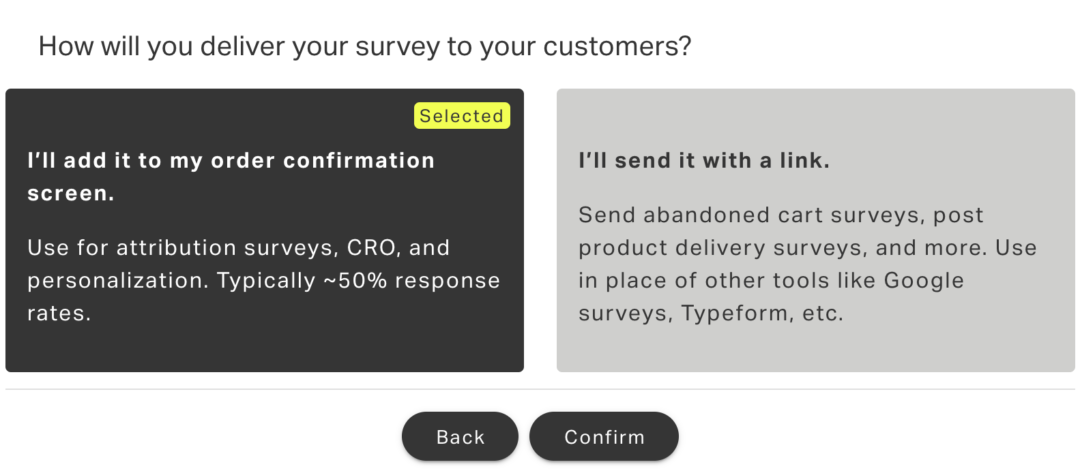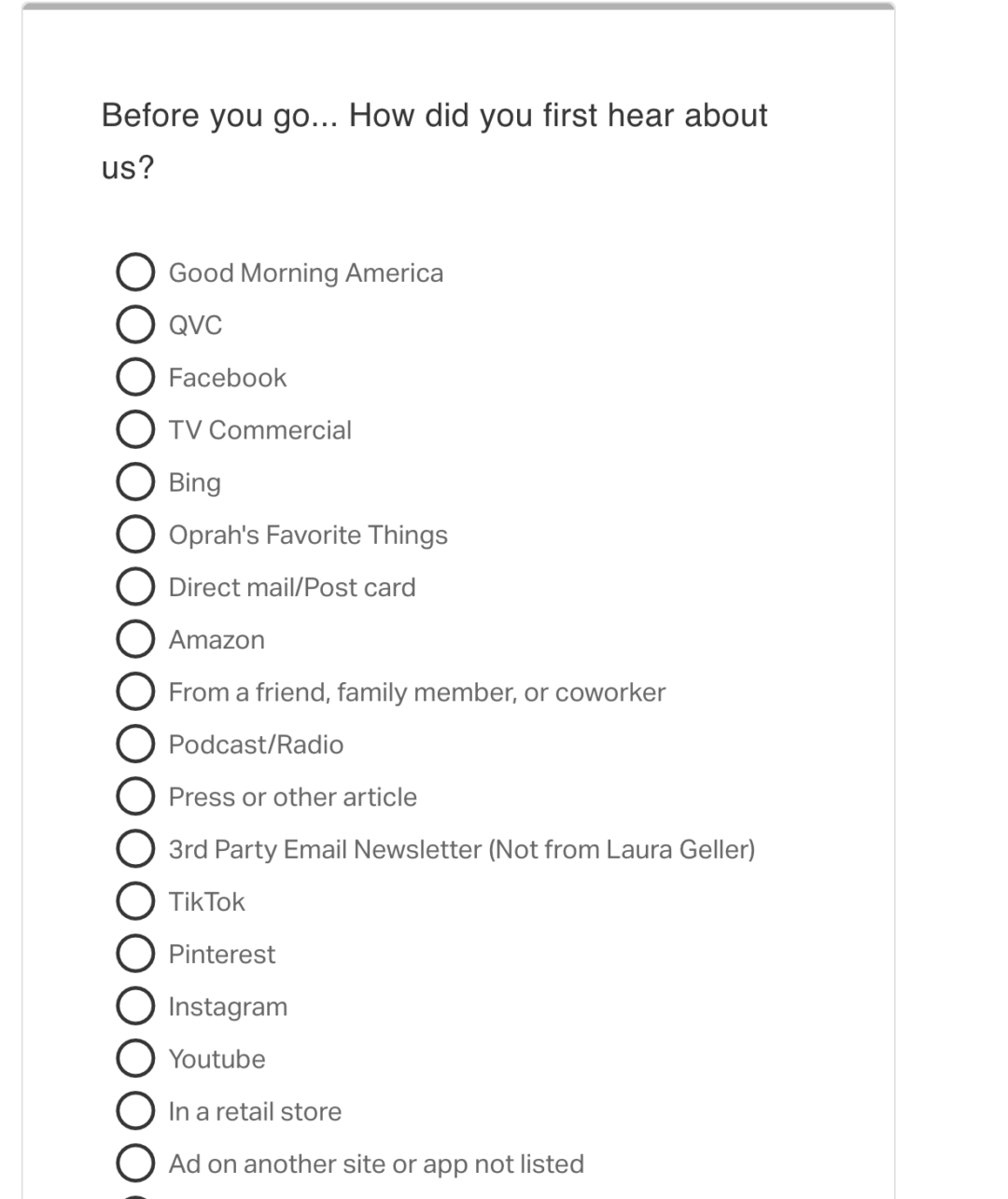
Ecommerce survey questions 101: why you need them, how to get started, and what to do with the data
Is someone purchasing from your ecommerce website a cause for celebration? Absolutely! It’s the culmination of your marketing and sales efforts.
Don’t go and buy your party supplies just yet, though. Your understanding of your customers shouldn’t begin and end with what they purchased from you.
Did you know:
- 41% of shoppers abandoned carts because they found the delivery fees too high?
- Or that 23.4% of customers discover and buy from a brand on the same day?
While your analytics may tell some of the story, there’s a person on the other side of your screen with human factors impacting purchase decisions. We’re not made of code—go figure!
Using ecommerce surveys post-purchase lets you understand your customers’ intent, how they found you, and why they made the purchase.
This can provide immeasurable benefits, including:
- Identifying potential issues and objections and using that feedback to drive future conversions
- Discovering first-hand what brings joy and frustration to your customers
- Enhanced customer satisfaction
- Amplified brand awareness
Look, if you’re just here for sample survey questions for ecommerce, we get it. Skip to the end of the article for immediate free access to our bank of 200+ survey questions.
However, if you’re unsure of whether an ecommerce survey is right for you, how to determine the best questions to ask, or the best way to use your responses, you’ve come to the right place.
What is an ecommerce survey?
An ecommerce survey is a tool used by online retailers to gather feedback and insights directly from their customers about various aspects of their shopping experience.
These surveys can cover a wide range of topics, such as product satisfaction, website usability, checkout process, post-purchase experience, and customer service. The goal is to collect valuable data that can help improve the business, increase customer satisfaction, and drive more sales.
There are typically two types of ecommerce surveys (KNO offers both):
- On-site survey: aptly titled, an on-site survey is a survey that appears on your site, usually as a popover or full-screen survey when people visit a page or complete an action like a purchase.
- Link survey: a survey shared with customers using a dedicated link, typically included in email flows or paid ads.

Within your survey, there are two types of questions you can ask:
- Open-ended questions: questions that allow the customer to type out their thoughts to gather qualitative data.
- Close-ended questions: multiple-choice questions with fixed options for answers to gather quantitative data.
Why should you be asking ecommerce survey questions?
Intent is of the utmost importance. The questions you ask need to be interesting enough to hold the customer’s attention but also serve a purpose.
You’ll only have a customer’s interest for a finite amount of time, so you must be sure that what you ask will lead to actionable insights. What good is collecting data if you can’t do anything with it?
That’s why we always recommend breaking down questions by purpose, audience, and product:
Purpose: why are you asking these survey questions? Is it for
- Attribution
- Product development
- Audience building
- Brand expansion
Audience: who are these questions for?
- New customers
- Returning customers
- Lapsed customers
Product: what product or service are you asking about?
- All of your products
- Sale-specific products
- Product bundles
- A specific product
Once you’ve identified what data you’re looking for, who you want to ask, and what you want to ask about, simply select the questions that align with your intent.
As mentioned, you can pull your questions directly from our free bank of ecommerce survey questions faster than it will take you to read this sentence.
But if you’re looking for more strategic direction, then read on for examples of question types by category:
30+ ecommerce survey questions by category
Attribution-based survey questions
Attribution-based ecommerce survey questions focus on where your customers came from, why they chose you, and why they ultimately made the purchase.

Some common questions include:
- How did you first hear about us?
- What ad do you remember seeing about us on TikTok?
- Was there another brand you were considering up until the moment you decided to buy from us?
- Did you use a search engine to do your research?
- What occasion was this purchase for?
- What made you decide to buy today?
- Why did you choose to buy on our website versus Amazon?
Market expansion survey questions
As the old saying (somewhat) goes, the customer you know is better than the one you don’t. When you’re looking to expand your product or service offerings, using KNO to ask market expansion questions to your existing customers is a great place to start.
For example, if you’re currently selling cookware and want to expand into selling bakeware, you could ask:
- Do you currently do a lot of baking?
- Would you be interested in baking more?
- What do you like to bake?
- What feature do you find is commonly missing from bakeware you’ve used?
- What features are most important to you in bakeware?
- What bakeware brands do you typically buy from?
- Where do you search for bakeware products?
Product innovation survey questions
Let’s spice this up with a controversial take: great marketing can’t fix a bad product. But ecommerce surveys can help improve one.
Product-market fit is the process of finding out whether your product is what your customers need. Strong marketing can push early adoption—and the use of ecommerce surveys with these early adopters is crucial to determining what customers want and need out of your product.
Product innovation survey questions are used to get customer feedback so you know what you’re doing well and what you can improve.
Common questions include:
- Did our product/service meet or exceed your expectations?
- What do you like about our product/service?
- What are your dislikes about our product/service?
- Which features of our product/service made you want to purchase it?
- What features do you wish we had?
- What features could you live without?
NPS survey questions
Can you believe we’ve gone this far without an acronym? It wouldn’t be an ecommerce blog without one!
Your NPS is your Net Promoter Score: a quantitative measurement of how likely a customer will recommend you to others. Scores fall between -100 to 100.
NPS survey questions are used to determine your NPS. Questions are asked using a 0 – 10 scale. With these results, subtracting detractors (a score of 6 or lower) from promoters (a score of 9 or 10) gives you your NPS. Once you KNO your NPS (pun intended), you can compare against your industry using benchmarks. Benchmarks for a “good” NPS vary across industries.
Depending on your offering, you may want to tweak your wording to best suit your customers:
- How likely are you to recommend us to your friends and family?
- How likely are you to recommend our product to your friends and family?
- How likely are you to recommend us to a colleague?
- How likely are you to recommend our product to a colleague?
CRO survey questions
Another acronym? That’s right — let’s talk CRO.
CRO is conversion rate optimization, which is essential to improving customer experience.
With CRO questions, you can gain insight into buyer motivation, identify patterns, optimize your purchase funnel, and determine what features your customers love most.
You get a glimpse inside your customer’s minds during the purchase process so you can add some fuel to your CRO efforts.
Here are some great questions to start with:
- What do you consider most important when choosing to shop with a brand? (quality of products, price point, brand values, sustainability, etc.)
- Did you face any obstacles during the checkout process?
- Were you able to find what you were looking for?
- What made you decide to buy today?
- What features do you love most about our product?
- What nearly stopped you from buying from us?
Customer behavior survey questions
Last but certainly not least are customer behavior survey questions. These questions shed light on how your customers shop online and the motivation behind their actions.
If you understand what your customers want from a shopping experience, you can tailor your web pages to meet those needs.
KNO allows you to ask these questions immediately after purchase when the experience is still fresh in your customers’ minds.
Common questions include:
- How satisfied were you with your shopping experience today?
- What did you think of our customer support team?
- What was the one thing that almost stopped you from buying?
- What payment options do you prefer?
- What made you choose our site to purchase from?
- How much do you typically spend on our website?
Ecommerce survey question template by industry
These sample questions are just the tip of the survey-shaped iceberg. As promised, we are providing free access to 200+ post-purchase survey questions here.
Our handy question bank allows you to sort by vertical, purpose, audience, and product to find the perfect questions for gathering relevant data.
Next steps: what to do with your survey data
Okay, you’ve used KNO to ask the right post-purchase ecommerce survey questions. Do you KNO what to do next?
Implement direct feedback
We’ve said this ad nauseum, but implementing customer feedback is essential to future success.
All the above questions will provide actionable insight for you to implement in your product/service, purchase process, ecommerce website, and more.
This data is invaluable. Identify trends and implement them accordingly.
Focus on re-acquisition
By adding a call-to-action at the end of your survey, you can provide opportunities for customers to re-engage.
Referrals, mobile outreach, email/SMS campaigns, loyalty initiatives, Facebook communities, Trustpilot reviews, and social media interactions are all compelling calls to action that foster customer engagement and nurture brand relationships.
Besides, KNO gets a 45% average response rate on its surveys, so it’s the perfect place to encourage the completion of an “action.”
For example, Only Curls used this action feature with KNO to push new and repeat customers to download their app.
It worked.
Using KNO, they drove an extra 1k clicks to their download page in 2 months. These are 1k customers who can now use the Tapcart mobile app to re-order and have a deeper relationship with Only Curls.
Sync your data across your tech stack
We’ll be blunt. We’re never going to be an email, SMS, subscription, or loyalty platform. Our singular goal is to build best-in-class solutions to learn more about your customers.
Worry not! We are super connected. You can sync your survey data across your tech stack to use your data where you need it most.
Integrations are always a top priority. We’ve broken them down into four buckets:
- MMM, MTA, and cloud-storage providers to contextualize survey responses with the rest of your attribution data:
Imagine your latest customer saw you on Instagram, Googled your brand and then visited your site. The UTM data will misrepresent the traffic source as “Google.”
We can set the record straight when the post-purchase surveys indicate they found you on Instagram, and sync those to your data platforms for consistent reporting.
These integrations help drive towards triangulation. We currently integrate with Rockerbox, Precient, Fospha, Triple Whale, BigQuery, S3, Redshift, Databricks, and Snowflake.
- Personalization tools, like email and SMS, to enrich customer profiles and segment buyers:
We already have deep integration with Klavyio, and integration with Yotpo, Sendlane, Attentive, and Postscript is coming very soon.
- Additional marketing tools where you can drive revenue from your surveys using our Actions feature:
This includes word-of-mouth referrals like Rivio and Talkable, affiliate platforms like Superfiliate and Social Snowball, and mobile apps like Tapcart.
Get started with KnoCommerce
A post-purchase platform like KnoCommerce is essential to gathering the right data to make the right changes to your ecommerce page, your products, and your brand.
Armed with our sample questions and templates for any use case, you can set up KNO in as little as five minutes. Start with a 7-day free trial here.